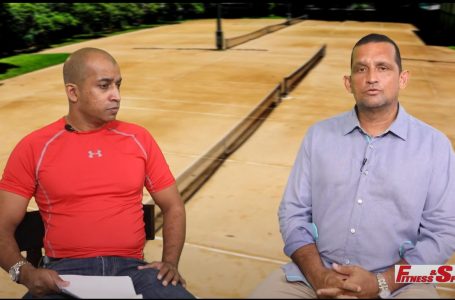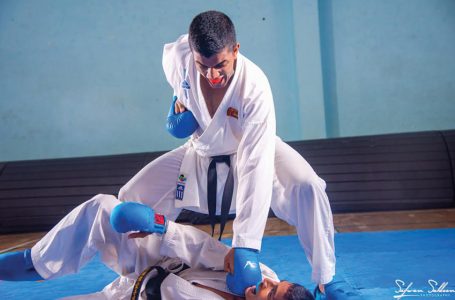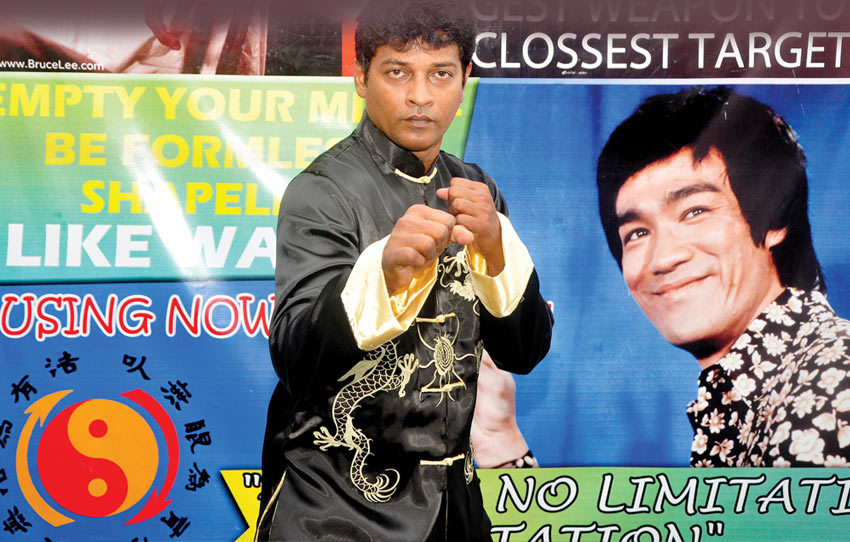
In volume ii of fitness & sports we introduced the fighting method of jeet kune do founded by martial arts legend bruce lee along with the story of jeet kune do master jagath caldera. This issue we will go to the practice of this fighting method to give our readers a basic idea on the workings of jeet kune do. To learn anything it is of utmost importance to understand and master the basics. That is why we first learn how to stand before we learn how to fight.
The On Guard Stance In Jeet Kune Do the most important/fundamental stance is the “On Guard”. This stance is the root for the tree of this fighting method. 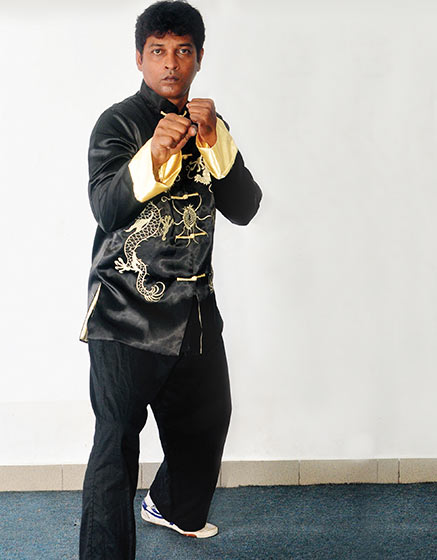 This stance has been created to defend an oncoming attack as well as to strike the opponent effectively.
This stance has been created to defend an oncoming attack as well as to strike the opponent effectively.
The “On Guard” stance gives the body a steady balance that also permits freedom of movement. This stance makes it difficult for the opponent to penetrate the defensive nature of the body’s position to make an effective strike. To summarise the defensive advantages of the “On Guard” are stability and the protection it gives to the fighter adopting this stance.
In attack the “On Guard” stance allows the fighter to strike the opponent with relative ease. It also makes it difficult for the opponent to predict our attack. This gives us the element of surprise in the attack making it more effective. To summarise the attacking advantage of this position are: Easy mobility to strike and the element of surprise in the attack due to the opponent’s inability to predict the nature of our strike.
Instructions: Leading with the Left/Orthodox
ead with your left foot. Your left toes should be pointing at a 25 degree angle.
Your right toes shoes should be at a 45 degree angle. Your right heel should be 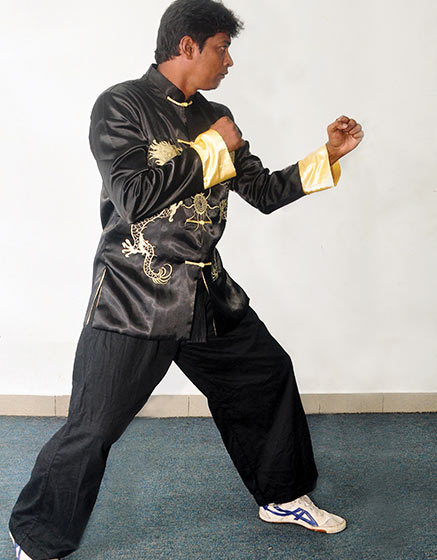 above the ground and only the balls of your right foot should touch the ground. It should be like a coil ready to spring into action.
Remember your weight should be slightly more on your lead left foot.
Your left shoulder should be facing forward towards your opponent and raised a little high to protect your chin. The shoulder should be near your chin but not touching it. Your lead elbow should be 6 to 8 inches in front of your ribs.
Your right hand should be near enough to cover your chin but not touching it. Keep both knees slightly bent.
above the ground and only the balls of your right foot should touch the ground. It should be like a coil ready to spring into action.
Remember your weight should be slightly more on your lead left foot.
Your left shoulder should be facing forward towards your opponent and raised a little high to protect your chin. The shoulder should be near your chin but not touching it. Your lead elbow should be 6 to 8 inches in front of your ribs.
Your right hand should be near enough to cover your chin but not touching it. Keep both knees slightly bent.
Instructions: Leading with the Right/Southpaw
Lead with you right foot. The right toes should be at a 25 degree angle.
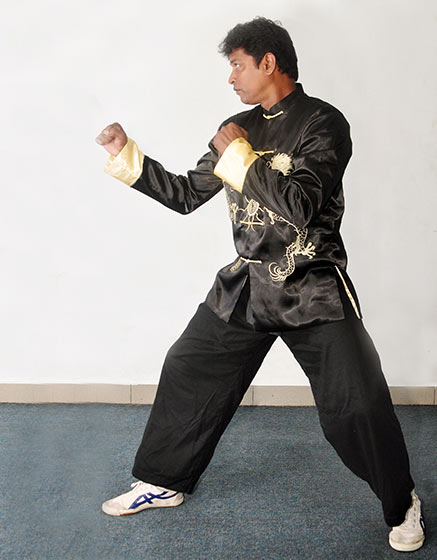 The toes on your left foot should be pointed at a 45 degree angle. The left foot should rest on the balls of the foot and the heel should be above the ground. Like a coil ready to spring into action.
Remember your weight should be placed slightly more on your right lead foot.
Your right shoulder should be facing forward towards your opponent and raised a little high to protect your chin. The shoulder should be near your chin but not touching it. Your lead elbow should be 6 to 8 inches in front of your ribs.
Your left hand should be near enough to cover your chin but not touching it. Keep both knees slightly bent.
The toes on your left foot should be pointed at a 45 degree angle. The left foot should rest on the balls of the foot and the heel should be above the ground. Like a coil ready to spring into action.
Remember your weight should be placed slightly more on your right lead foot.
Your right shoulder should be facing forward towards your opponent and raised a little high to protect your chin. The shoulder should be near your chin but not touching it. Your lead elbow should be 6 to 8 inches in front of your ribs.
Your left hand should be near enough to cover your chin but not touching it. Keep both knees slightly bent.
Fencing and Western Boxing Influences
Master Bruce Lee took the foot movement from the art of fencing and incorporated it as the base for full body movements in forming the On Guard Stance. After every move the JKD fighter must return to the On Guard stance. Balance is very important to protect the fighter so that is why the On Guard Stance ensures that proper balance is always maintained.
The stance has incorporated the principle of Western Boxing which easily allows easy movement for the upper body. As you can see the principle of Fencing facilitates easy movement of the whole body and the principles of Western Boxing facilitates easy movement of the upper body. This allows the JKD fighter to avoid any incoming attack to the head and upper body.
After every move the JKD fighter must return to the On Guard stance. Balance is very important to protect the fighter so that is why the On Guard Stance ensures that proper balance is always maintained.
The stance has incorporated the principle of Western Boxing which easily allows easy movement for the upper body. As you can see the principle of Fencing facilitates easy movement of the whole body and the principles of Western Boxing facilitates easy movement of the upper body. This allows the JKD fighter to avoid any incoming attack to the head and upper body.
Blocking the Opponents Attacks
Blocks in JKD always include body movements. There are no blocks without body movements. This is because if we try to block an attack while remaining still, there is room for the opponent’s strike to connect with our body. Even while remaining still, if we block the opponent’s strike we are limited to counter attacking. Thus the defense will not be complete without movement of the body. Our rear foot positioned like a coil ready to spring plays an important role to permit easy movement. Once again, Jeet Kune Do philosophy stresses to return to the On Guard Stance after each movement maintaining the correct foot positioning angles and the distance between the feet.
JAGATH CHANDANA CALDERA
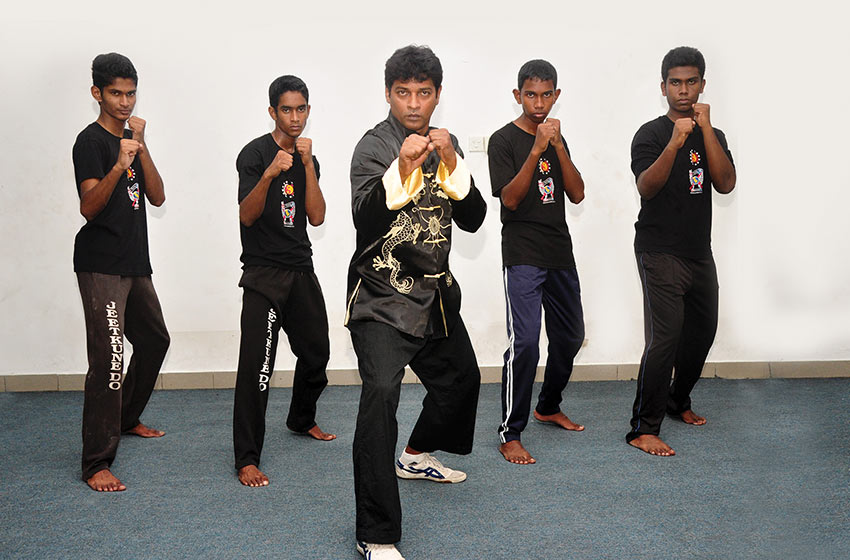
Jagath is the founder & chief instructor of the Sri Lanka Jeet Kune Do Association registered under the Sports Ministry. He is the former physical fitness & mental well being trainer of the Sri Lanka Golf Team and the Sri Lanka Navy Golf Team.
Jagath has been trained by International Jeet Kune Do instructors such as Rocky Randel. Rocky Randel was trained by Dan Inosanto a student of Bruce Lee making Jagath a 3rd generation student of Bruce Lee. Jagath is also a certified Jeet Kune Do Instructor from The Liahona Warrior Arts International USA.
JAGATH CHANDANA GYM & MARTIAL ART ACADEMY
555/2 / E 1 Thalangama North, Thalahena, Battaramulla
Tel: 0777 572 075, E-mail: jagathkaldera@yahoo.com


